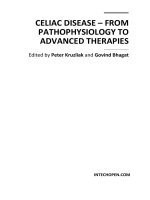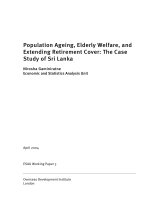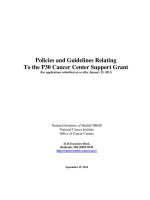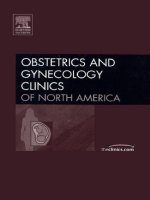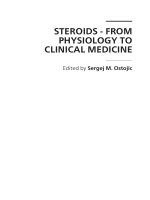Understanding Tuberculosis – Global Experiences and Innovative Approaches to the Diagnosis Edited by Pere-Joan Cardona potx
Bạn đang xem bản rút gọn của tài liệu. Xem và tải ngay bản đầy đủ của tài liệu tại đây (10.67 MB, 562 trang )
UNDERSTANDING
TUBERCULOSIS – GLOBAL
EXPERIENCES AND
INNOVATIVE APPROACHES
TO THE DIAGNOSIS
Edited by Pere-Joan Cardona
Understanding Tuberculosis
–
Global Experiences and Innovative Approaches
to the Diagnosis
Edited by Pere-Joan Cardona
Published by InTech
Janeza Trdine 9, 51000 Rijeka, Croatia
Copyright © 2012 InTech
All chapters are Open Access distributed under the Creative Commons Attribution 3.0
license, which allows users to download, copy and build upon published articles even for
commercial purposes, as long as the author and publisher are properly credited, which
ensures maximum dissemination and a wider impact of our publications. After this work
has been published by InTech, authors have the right to republish it, in whole or part, in
any publication of which they are the author, and to make other personal use of the
work. Any republication, referencing or personal use of the work must explicitly identify
the original source.
As for readers, this license allows users to download, copy and build upon published
chapters even for commercial purposes, as long as the author and publisher are properly
credited, which ensures maximum dissemination and a wider impact of our publications.
Notice
Statements and opinions expressed in the chapters are these of the individual contributors
and not necessarily those of the editors or publisher. No responsibility is accepted for the
accuracy of information contained in the published chapters. The publisher assumes no
responsibility for any damage or injury to persons or property arising out of the use of any
materials, instructions, methods or ideas contained in the book.
Publishing Process Manager Marija Radja
Technical Editor Teodora Smiljanic
Cover Designer InTech Design Team
First published February, 2012
Printed in Croatia
A free online edition of this book is available at www.intechopen.com
Additional hard copies can be obtained from
Understanding Tuberculosis – Global Experiences and Innovative Approaches to the
Diagnosis, Edited by Pere-Joan Cardona
p. cm.
ISBN 978-953-307-938-7
Contents
Preface IX
Part 1 Experience on Laboratory Diagnosis Around the World 1
Chapter 1 Clinical Laboratory Diagnostics for
Mycobacterium tuberculosis 3
N. Esther Babady and Nancy L. Wengenack
Chapter 2 Laboratory Diagnosis of Latent and Active Tuberculosis
Infections in Trinidad & Tobago and Determination
of Drug Susceptibility Profile of Tuberculosis
Isolates in the Caribbean 37
Patrick Eberechi Akpaka and Shirematee Baboolal
Chapter 3 Tuberculosis is Still a Major Challenge in Africa 59
Simeon I.B. Cadmus, Osman, El Tayeb and Dick van Soolingen
Chapter 4 Tuberculosis in Saudi Arabia 71
Sahal Al-Hajoj
Chapter 5 Diagnosis of Mycobacterium tuberculosis 87
Faten Al-Zamel
Chapter 6 Diagnosis of Smear-Negative Pulmonary Tuberculosis in
Low-Income Countries: Current Evidence in Sub-Saharan
Africa with Special Focus on HIV Infection or AIDS 127
Claude Mambo Muvunyi and Florence Masaisa
Chapter 7 Immunologic Diagnosis of Neurotuberculosis 147
Iacob Simona Alexandra, Banica Dorina, Iacob Diana Gabriela,
Panaitescu Eugenia, Radu Irina and Cojocaru Manole
Chapter 8 Diagnostic Methods for Mycobacterium tuberculosis
and Challenges in Its Detection in India 171
Shamsher S. Kanwar
VI Contents
Chapter 9 Management of TB in HIV Subjects,
the Experience in Thailand 183
Attapon Cheepsattayakorn
Chapter 10 Mycobacterium tuberculosis:
Biorisk, Biosafety and Biocontainment 203
Wellman Ribón
Part 2 New Approaches to the TB Diagnosis 237
Chapter 11 New Diagnostics for Mycobacterium tuberculosis 239
Michaela Lucas, Andrew Lucas
and Silvana Gaudieri
Chapter 12 Nanodiagnostics for Tuberculosis 257
Bruno Veigas and Gonçalo Doria and Pedro V. Baptista
Chapter 13 Sputum Smear Microscopy for Tuberculosis:
Evaluation of Autofocus Functions and Automatic
Identification of Tuberculosis Mycobacterium 277
Cicero F. F. Costa Filho and Marly G. F. Costa
Chapter 14 The Use of Phage for Detection, Antibiotic
Sensitivity Testing and Enumeration 293
Catherine Rees and George Botsaris
Chapter 15 Molecular Imaging in TB: From the Bench to the Clinic 307
Nuria Andreu, Paul T. Elkington and Siouxsie Wiles
Chapter 16 Data Mining Techniques in the
Diagnosis of Tuberculosis 333
T. Asha, S. Natarajan and K. N. B. Murthy
Chapter 17 Immunological Diagnosis of Active and Latent TB 353
Beata Shiratori, Hiroki Saitoh, Umme Ruman Siddiqi,
Jingge Zhao, Haorile Chagan-Yasutan,
Motoki Usuzawa, Chie Nakajima,
Yasuhiko Suzuki and Toshio Hattori
Chapter 18 Immune Diagnosis of Tuberculosis
Through Novel Technologies 379
Miguel A. Arroyo-Ornelas, Ma. Concepción Arenas-Arrocena,
Horacio V. Estrada, Victor M. Castaño and Luz M. López-Marín
Chapter 19 Exosomes: New Tuberculosis Biomarkers –
Prospects From the Bench to the Clinic 395
Nicole A. Kruh-Garcia, Jeff S. Schorey and Karen M. Dobos
Contents VII
Chapter 20 Molecular Techniques for Identification of Species
of the Mycobacterium tuberculosis Complex:
The use of Multiplex PCR and an Adapted HPLC Method
for Identification of Mycobacterium bovis and
Diagnosis of Bovine Tuberculosis 411
Eduardo Eustáquio de Souza Figueiredo, Carlos Adam Conte
Júnior, Leone Vinícius Furlanetto, Flávia Galindo Silvestre Silva,
Rafael Silva Duarte, Joab Trajano Silva,
Walter Lilenbaum
and Vânia Margaret Flosi Paschoalin
Part 3 Improving Detection and Control of Resistances 433
Chapter 21 Survey and Molecular Characterization of Drug- Resistant
M. tuberculosis Clinical Isolates from Zunyi,
Guizhou Province of China 435
Ling Chen, Hong Zhang, Jian-Yong Zhang, Na-Na Li, Mei Liu,
Zhao-Jing Zong, Jian-Hua Wang and Sheng-Lan Wang
Chapter 22 Molecular Biological Techniques for Detection of
Multidrug Resistant Tuberculosis (MDR) and Extremely
Drug Resistant Tuberculosis (XDR) in Clinical Isolates
of Mycobacterium tuberculosis 455
K.L. Therese, R. Gayathri and H.N. Madhavan
Chapter 23 Detection of Mycobacterium tuberculosis
and Drug Resistance: Opportunies and
Challenges in Morocco 471
I. Chaoui, M. Abid, My. D. El Messaoudi and M. El Mzibri
Chapter 24 Pattern of Circulating Mycobacterium tuberculosis
Strains in Sri Lanka 511
Dhammika Magana-Arachchi
Chapter 25 Health Interventions to Improve the Medication
Efficacy in Tuberculosis Treatment 527
Jean Leandro dos Santos, Chung Man Chin, Ednir de Oliveira
Vizioli, Fernando Rogério Pavan and Luiz Antonio Dutra
Preface
Mycobacterium tuberculosis is a disease that is transmitted through aerosol. This is the
reason why it is estimated that a third of humankind is already infected by
Mycobacterium tuberculosis. The vast majority of the infected do not know about their
status. Mycobacterium tuberculosis is a silent pathogen, causing no symptomatology at
all during the infection. In addition, infected people cannot cause further infections.
Unfortunately, an estimated 10 percent of the infected population has the probability
to develop the disease, making it very difficult to eradicate. Once in this stage, the
bacilli can be transmitted to other persons and the development of clinical symptoms
is very progressive. Therefore the diagnosis, especially the discrimination between
infection and disease, is a real challenge. In this book, we present the experience of
worldwide specialists on the diagnosis, along with its lights and shadows.
Dr. Pere-Joan Cardona
Institut Germans Trias i Pujol (IGTP)
Catalunya, Spain
Part 1
Experience on Laboratory
Diagnosis Around the World
1
Clinical Laboratory Diagnostics for
Mycobacterium tuberculosis
N. Esther Babady
1
and Nancy L. Wengenack
2
1
Memorial Sloan-Kettering Cancer Center, New York, New York,
2
Mayo Clinic, Rochester, Minnesota,
USA
1. Introduction
This chapter highlights current state-of-the-art methods for the detection and identification
of Mycobacterium tuberculosis (Mtb) complex in the clinical diagnostic laboratory. Methods
discussed include stain and culture which traditionally would have been followed by
phenotypic-based identification methods. At this point in time however, molecular methods
are considered the gold standard for both the rapid detection of Mtb directly from patient
specimens as well as for the identification of Mtb following growth in culture. There are also
instances where speciation of Mtb in order to distinguish it from other members of the Mtb
complex is clinically important and these will be discussed. In addition, this chapter
provides an overview of methods used in the clinical laboratory for Mtb drug resistance
testing and suggests what the future might hold for Mtb diagnostics.
2. M. tuberculosis and biosafety in the clinical laboratory
M. tuberculosis presents a risk of laboratory-acquired infection due to its transmission via
aerosol routes, ability to withstand common laboratory processing techniques such as heat-
fixation or frozen section preparation and a extremely low ID
50
of <10 bacilli. The United
States Centers for Disease Control and Prevention (CDC) estimates that laboratory workers
are three times more likely than non-laboratory workers to become infected with Mtb.
Therefore, biological safety organizations have defined a number of safety practices and
procedures that must be strictly followed when working with Mtb which is classified as a
risk group 3 organism. Specimens and cultures of unknown isolates shall be handled as if
they contain Mtb until proven otherwise. Only non-aerosol generating processes such as
accessioning of specimen or reading of acid-fast smears can be done under BSL-2 conditions
outside of a BSC. All other specimen-handling including opening/closing of tubes, pipeting
and transfer must be done in a BSC. Personnel must exercise caution to avoid aerosol
generation. More specifically, smear preparation, culture decontamination and
concentration, and culture plating must be done inside a BSC with the possible exception of
the centrifugation step. However, centrifugation must be done using aerosol-proof
containers which are opened, loaded and closed inside the BSC to reduce the risk of
personnel exposure. All laboratory surfaces must be decontaminated with a tuberculocidal
reagent before and after working with specimens and cultures. Propagation and
Understanding Tuberculosis – Global Experiences and Innovative Approaches to the Diagnosis
4
manipulation of Mtb complex cultures (e.g., identification and susceptibility testing)
requires BSL-3 practices, equipment and facilities. Clinical laboratories without BSL-3
facilities must refer all positive mycobacterial cultures to another laboratory with BSL-3
capabilities for identification and, if necessary, susceptibility testing. Acid-fast smears must
not be prepared from positive mycobacterial cultures of unknown identity without BSL-3
facilities. Identification methods (e.g., biochemical analysis, nucleic acid hybridization
probes, sequencing, PCR) required initial specimen processing under BSL-3 conditions until
any viable mycobacteria have been rendered non-viable by heating and/or lysis via
chemical or physical means. Laboratories must verify that their processing methods are
effective in rendering Mtb nonviable prior to conducting any activities outside of a BSL-3
laboratory.
BSL-3 facilities have highly specialized requirements some of which include restricted
laboratory access, self-closing double door entry, directional airflow with a specified
number of air exchanges over time, BSCs exhausted to the outside, and posted signage
regarding the hazard (in this case Mtb). Class II BSCs are one of the most important pieces of
equipment in the mycobacteriology laboratory and they must be maintained in good
working order at all times. Frequent (at least daily) checks of function by means such as
magnehelic gauge monitoring is needed. Regular maintenance and certification programs
must be undertaken and documentation of cabinet performance must be maintained by the
laboratory. Specimens should be covered before transport and should be transported in
well-sealed, leak-proof containers. All biohazard waste should be autoclaved prior to
leaving the facility.
BSL-3 personnel safety practices include the use of fluid-resistant, cuffed, solid-front
gowns, gloves, eye protection, respiratory protection (N-95 or better fitted respirator or
powered air purifying respirator (PAPR)). Each laboratory must perform a risk
assessment to define the personal protective equipment, facilities and engineering
practices that are appropriate for their institution and that comply with applicable
regulations. The risk assessment is the responsibility of the laboratory director but it
should be done in collaboration with institutional biosafety officials as this is helpful in
making certain that no safety practice has been overlooked. A sample risk assessment is
provided in Table 1 but each laboratory must perform their own assessment as situations
may differ between laboratories. The laboratory must have a written spill procedure and
must review the procedure with lab staff regularly to assure competency. Spill “drills” in
which staff physically respond to a simulated spill are highly recommended as they
routinely point out any potential gaps in procedures or staff knowledge.
Strict regulations exist in many countries concerning the shipping and transportation of
diagnostic specimens that are known to contain or that potentially contain Mtb complex and
for shipment of known Mtb complex isolates. Personnel who package these specimens and
isolates must have specialized training that is updated at prescribed intervals. Packaging
materials must be leak-proof, able to withstand unpredictable handling throughout the
transportation chain and must be properly labeled in order to alert transportation workers
of hazards contained within the package. Individuals involved in the shipping of specimens
and isolates should be knowledgeable about the regulations within their country and if,
sending specimens or isolates internationally, within the destination country.
Clinical Laboratory Diagnostics for Mycobacterium tuberculosis
5
Procedure
Aerosol
Potential
Biosafety
Level
Required
Personal
Protective
Equipment
Required
Engineering
Controls
Required
Special Practices or
Equipment Required
Reading of
smears (AR,
Kinyoun,
Modified Acid
Fast)
Slight BSL 2 Gown, gloves
May be done on
bench top
Manipulation
of
mycobacterial
cultures for
identification
(e.g.
subculturing)
Significant BSL 3
Gown, shoe
covers, eye
protection,
gloves and
respirator/head
cover or PAPR
Work in biological
safety cabinet
Use disposable loops;
Use racks to prevent
tipping/spilling;
Work over
disinfectant-soaked
towel
Susceptibility
testing of
mycobacteria
Significant
BSL 3 for
setup
BSL 2 for
incubation
and
reading of
closed
bottles/
plates/
tubes
Setup - Gown,
shoe covers, eye
protection, gloves
and
respirator/head
cover or PAPR
Work in biological
safety cabinet to
inoculate bottles,
tubes or plates
with organism
Use extreme care to
avoid aerosol
generation when
inoculating
bottles/plates/tubes
Table 1. Sample partial risk assessment – this table is intended as an example of one style of
risk assessment that can be developed. Each laboratory must develop a laboratory-specific
risk assessment in conjunction with their institutional safety officer(s).
3. Stains for mycobacteria
Mycobacteria, including Mtb complex, can be rapidly and inexpensively detected directly
from pretreated and concentrated respiratory specimens, body fluids, and tissue using
acid-fast stains. A Gram stain is not able to reliably detect mycobacteria which can appear
as non-stained “ghosts” or as beaded Gram-positive bacilli. Therefore, acid-fast stains,
such as the Ziehl-Neelsen stain or the fluorescent auramine-rhodamine stain are
recommended for mycobacteria. The acid-fast stain forms a complex between the unique
mycolic acids of the mycobacterial cell wall and the dye (e.g., fuchsin). Complex
formation makes the mycobacteria resistant to destaining by acid-alcohols providing the
basis for the “acid-fast” terminology. Non-acid fast bacteria do not retain the acid-fast dye
in the presence of the acid-alcohol decolorizer and are often stained in a subsequent step
using a counterstain such as methylene blue. Commonly utilized acid-fast stains contain
carbol-fuchsin dye and are the Ziehl-Neelsen stain which utilizes phenol plus heat to aid
in dye penetration, and the Kinyoun stain which uses phenol in the absence of heat. The
Ziehl-Neelsen stain is considered the more sensitive of the two (Somoskovi et al., 2001).
Fluorescent stains such as auramine O are also used alone or in combination with
rhodamine B. The fluorescent stains exhibit increased fluorescence upon binding DNA
and RNA providing enhanced sensitivity for examining concentrated direct specimens by
Understanding Tuberculosis – Global Experiences and Innovative Approaches to the Diagnosis
6
staining the bacilli while avoiding non-specific staining of artifacts and background more
typical of the non-fluorescent stains.
Mycobacteria appear as long slender rods (1-10µm long x 0.2-0.6µm wide) and are often
slightly curved or bent. At least 300 fields should be examined under high power (1000X)
when using a carbol-fuchsin stain and light microcopy. The fluorochrome stain can be
examined using a lower power (250X) and a minimum of 30 fields should be examined
under the lower power (Pfyffer & Palicova, 2011). When positive, an indication of the
quantity of acid-fast bacilli present should be provided. Factors which influence the
sensitivity of acid-fast smears include the amount of acid-fast bacilli present in the
specimen, the experience of the reader, the stain used, the number of fields examined, the
type of specimen (e.g., generally respiratory specimens have higher yield than non-
respiratory), the patient population being examined, volume of the specimen and smear pre-
treatment (direct vs. pre-treated, concentrated). Rigid quality control processes must be
followed to prevent cross-contamination and false results. Laboratories should use a
positive and negative control slide for each batch of acid-fast smears prepared and should
have a second reader confirm positive results and at least 10% of negative slides to reduce
the potential for incorrect results. Staining jars or dishes should not be used to prevent
potential cross-contamination and care should be taken to avoid the transfer of bacilli via the
microscopy oil used for examining the slide. Laboratories must also participate in a
proficiency testing programs (e.g., College of American Pathologists) to ensure continued
competency.
Acid-fast stains lack sensitivity and a large number of bacilli (10
4
-10
6
/mL) are required for a
positive stain. Therefore, a positive stain from a respiratory specimen is typically thought to
correlate with a higher infectivity potential and patients are routinely placed in airborne
isolation rooms until their acid-fast smears convert to negative. Immunocompromised
individuals often present with lower bacterial loads making detection by smear difficult
(Chegou et al., 2011). Up to 30% of persons (commonly children) are unable to produce
sputum for a smear requiring the use of more invasive methods (gastric washing,
bronchoalveolar lavage, etc). Smears can be used to follow the response to treatment in
smear-positive individuals. A concentration step provides increase sensitivity over direct
smear microscopy (Steingart et al., 2006).
Acid-fast stains are also non-specific and the reader cannot determine the species of
mycobacteria present in a positive smear. Mycobacteria tend to clump and produce cord-
like strands of bacilli and there may be some indication of which species is present based on
characteristic cording but this is highly subjective and not recommended as a routine
method of determining species (Attorri et al., 2000; Julian et al., 2010).
4. Culturing of M. tuberculosis
The growth of Mtb in culture is considered the gold standard for identification of a case of
tuberculosis. The sensitivity of culture is much better than an acid-fast smear with only 10-
100 viable organisms/mL of specimen required for a positive culture. Media for the growth
of Mtb is the same as that used for other mycobacteria species and generally includes both a
solid and a liquid-based medium. Solid media utilized is typically either egg-based such as
the Lowenstein-Jensen (L-J) medium or agar-based such as Middlebrook 7H10 medium.
Clinical Laboratory Diagnostics for Mycobacterium tuberculosis
7
Antimicrobial agents can be added to help with elimination of contaminating organisms
which may have a more rapid growth rate than Mtb and which may therefore obscure any
Mtb present on the plate. In general, Mtb colonies are seen more rapidly on agar-based
medium (10-12 days) as opposed to egg-based medium (18-24 days) (Liu et al., 1973). Care
must be taken to protect Middlebrook medium from excessive light and heat which results
in breakdown of the medium and release of a formaldehyde byproduct which is toxic to Mtb
(Miliner et al., 1969). Use of Middlebrook 7H11 medium containing casein is reported to
improve the recovery of isoniazid-resistant isolates of Mtb (Pfyffer & Palicova, 2011). Broth
medium such as Middlebrook 7H9 medium is reported to provide a more rapid recovery of
Mtb compared with solid medium. There are several commercially-available semi-
automated broth culture systems for mycobacteria including Mtb complex. The BACTEC
460 radiometric and BACTEC 960 Mycobacterial Growth Indicator Tube (MGIT)
fluorimetric systems (Becton, Dickinson, Sparks, MD) and the VersaTREK culture system
(TREK Diagnostics Systems, Cleveland, OH) are FDA-cleared in the United States. The
BACTEC 460 system is currently being phased out by the manufacturer in favor of the non-
radiometric MGIT system. Other culture systems include Septi-Chek biphasic System
(Becton, Dickinson,) and the MB/BacT Alert 3D system (bioMérieux, Marcy l'Etoile, France)
which has a colorimetric CO
2
-based sensor to detect mycobacterial growth. There are
numerous publications in the literature which compare the performance of the
commercially-available broth systems but in general, these systems have a sensitivity of 88-
93% for the detection of Mtb complex (Cruciani et al., 2004).
Cultures for Mtb complex should be incubated at 35-37ºC in an atmosphere of 5-10% CO
2
for
primary cultures on solid medium. Since Mtb complex grows slowly in culture, many
laboratories choose to examine culture plates for growth twice per week during early stages
of growth and then weekly for older cultures. The advantage of semi-automated broth
systems such as the MGIT and VersaTREK are that CO
2
-supplementation is not generally
required and the cultures are continuously monitored without the need for laboratory
technologist intervention unless a culture is flagged by the instrument as positive. After
either a solid or broth culture shows growth, the presence of acid-fast bacilli must be
confirmed as described below in order to rule out non-mycobacterial contaminants.
5. Identification of M. tuberculosis from culture isolates
5.1 Microscopy
The first step in the examination of organisms growing on either solid media or liquid
media is to confirm their identity using various staining methods as discussed in section 3.
Depending on the stain used, the identification of Mycobacterium bacilli is done using either
a light microscope under 100 x oil immersion objective or a fluorescent microscope under
25x or 40x objective. Microscopy however is not specific and cannot differentiate Mtb from
other Mycobacterium and further analysis is required for final identification which can take
up to 4-6 weeks.
Recently, the Microscopic Observation Drug Susceptibility (MODS) assay has been reported
for the detection of Mtb complex in liquid culture through microscopic observation of
characteristic cording and this method is characterized as in “late stage
development/evaluation” for use in high TB burden settings by the World Health
Understanding Tuberculosis – Global Experiences and Innovative Approaches to the Diagnosis
8
Organization (WHO) (Caviedes & Moore, 2007; Moore, 2007; WHO, 2008; Ha et al., 2009;
Limaye et al., 2010).
5.2 Biochemical analysis
Following microscopic and microscopic examination of culture isolates, final identification
to the species level of Mtb complex is performed using a set of conventional biochemical
reactions in combination with growth temperature. Although conventional biochemical
assays are relatively inexpensive and simple to perform, they are time-consuming due to
required incubation periods of up to 4 weeks, resulting in major delays in identification.
Furthermore, with greater than 130 mycobacterial species identified to date, the use of
phenotypic methods is limited and biased to identify only the most common species of
mycobacteria, underestimating the complexity of the genus and resulting in
misidentification of unfamiliar species (Kirschner et al., 1993; Springer et al., 1996). M.
tuberculosis, as with other members of the Mtb complex, is a slow growing mycobacterium,
requiring in general 15 days to 40 days to grow in culture. The optimal isolation
temperature for the organism is 35-37°C and the organism does not produce pigmentation
even following exposure to light (non-chromogen). The most useful biochemical tests used
for identification of a nonchromogenic, slow-growing mycobacterium such as Mtb complex
includes: niacin accumulation, nitrate reduction, pyrazinamidase activity, inhibition of
thiophene-2-caroxylic acid hydrazide, urease activity and catalase activity. Other tests that
can provide additional information include tellurite reduction, Tween 80 hydrolysis, the
arylsulfatase test, iron uptake and NaCl tolerance. In general, a mature growth (2-3 weeks)
is required for biochemical tests, they are often performed on a LJ slants and require up to 3
weeks for final read of results.
5.2.1 Niacin accumulation
Niacin (nicotinic acid) is produced by all species of mycobacteria and further metabolized to
nicotinamide adenine dinucleotide (NAD). However, Mtb complex, M. simiae and some
strains of M. chelonae, M. bovis, and M. marinum do not have the enzyme responsible for
metabolizing niacin, resulting in its accumulation in the culture media. A water extract is
prepared by adding 1 mL of sterile water to the surface of an LJ slant with a growth of
mycobacteria species at least three weeks-old. An aliquot of this extract is then added to a
tube containing a niacin strip, incubated for up to 30 minutes with gentle shaking. A
positive reaction (presence of niacin) is read as the development of a yellow color. Since
species other than Mtb complex can accumulate niacin, additional biochemical testing is
required for the final identification of Mtb complex.
5.2.2 Nitrate reduction
M. tuberculosis complex contains the enzyme nitroreductase which is able to reduce nitrate
(NO
3
) into nitrite (NO
2
). This reaction is detected in the laboratory by inoculating a nitrate
broth with a loopful of a 3-4 weeks old mycobacterial culture and α-napthalamine, and
sulfanilic acid that will react with the released NO
2
to produce a red or pink color. A
negative result (lack of color) is further confirmed by the addition of zinc dust. If a red color
(nitrate reduced) develops following addition of zinc dust, then the original result is
confirmed as negative.
Clinical Laboratory Diagnostics for Mycobacterium tuberculosis
9
5.2.3 Pyrazinamidase
The deamination of pyrazinamide into pyrazinoic acid and ammonia by the enzyme
pyrazinamidase (PZA) is an essential test to distinguish Mtb complex (PZA positive) from
M. bovis (PZA negative). Other non-tuberculous mycobacteria species including M.
marinum and M. avium complex can also be positive for PZA. The test is performed by
inoculating two LJ slants with the mycobacterium species and incubating them for 4 days
at 35-37°C in a non-CO
2
incubator. After 4 days, 1% ferric ammonium sulphate is added to
one of the tube and incubated at room temperature for 30 minutes. The PZA reaction is
positive if a pink band forms on the surface of the LJ slant. If the reaction is negative, the
LJ slant is incubated for an additional 4 hours at 2-8 °C and observed for the appearance
of the pink band. If the test is still negative after 4 hours, the second tube will be tested on
day 7 to finalize the test.
5.2.4 Urease
The presence of urease, the enzyme that hydrolyzes urea into ammonia and carbon dioxide,
can be detected in mycobacterial species by incubating an actively growing culture to a urea
broth for up to 7 days at 35-37°C in a non-CO
2
incubator, with readings done at days 1, 3
and 7. M. tuberculosis complex is positive for urease and will produce a dark pink to red
color following incubation in urea broth.
5.2.5 Inhibition of thiophene-2-caroxylic acid hydrazide (TCH)
M. tuberculosis complex can be differentiated from M. bovis by its ability to grow in the
presence of TCH, a property shared by most mycobacteria species except for M. bovis. This
test uses quadrant Petri dishes with one of the quadrant containing TCH. A dilute
suspension of the mycobacterial growth (10
-3
to 10
-4
in sterile water) is added to each
quadrant and the plate incubated for 3 weeks at 35-37°C in a 10 % CO
2
incubator. A resistant
organism shows greater than 1% growth in the TCH quadrant when compared to growth in
the control quadrant.
5.2.6 Arylsulfatase test
Arylsulfatase is an enzyme that hydrolyzes free phenolphthalein from the tri-potassium salt
of phenolphthalein disulfite. A suspension of a pure mycobacterium culture in sterile water
is incubated with phenolphthalein in oleic acid agar for either 3 days (rapid growers) or 14
days (slow growers) at 35-37°C in a non-CO
2
incubator. The appearance of a pink or red
color after addition of sodium bicarbonate (Na
2
CO
3
) indicates a positive reaction. All
members of the Mtb complex lack the arylsulfatase enzyme and are therefore negative for
that reaction (Koneman, 2006; Lee, 2010).
5.2.7 Catalase test
Catalase is an enzyme that splits hydrogen peroxide (H
2
O
2
) into water (H
2
O) and oxygen
(O
2
). Unlike the catalase assay used to identify for other types of bacteria (i.e. Streptococcus
spp.), the catalase assay for mycobacteria is performed using 30% H
2
O
2
(Superoxol) in 10%
Tween-80 and the test performed both at 22-25°C and 68°C. M. tuberculosis complex has
Understanding Tuberculosis – Global Experiences and Innovative Approaches to the Diagnosis
10
catalase activity at 22-25°C but not at 68°C (ie., heat-labile catalase). In addition to
determining catalase activity at 68°C, the strength of the catalase reaction is also evaluated
to differentiate Mtb complex from other mycobacteria. This semiquantitative test is
performed by adding Superoxol to a 2-weeks-old culture of mycobacteria growing on a
Lowenstein-Jensen slant at 37°C. Five minutes after addition of the Superoxol, the strength
of the catalase reaction is determined by measuring the height of the bubbles, characteristic
of the catalase reaction, in the tube. If the height of the bubbles is > 45 mm, the reaction is
considered high and if the height of the bubbles is < 45 mm, the reaction is considered low.
M. tuberculosis complex has low catalase activity.
5.2.8 Iron uptake
Only a few mycobacteria species are able to take up iron from ferric ammonium citrate and
convert it to iron oxide (rust). This biochemical reaction is mainly used to identify M.
fortuitum which when incubated with 20% ferric ammonium citrate for up to 3 weeks on a
Lowenstein-Jensen slant at 28-30°C will turn a dark, rusty brown color. M. tuberculosis
complex does not take up iron.
5.2.9 NaCl tolerance
The ability to grow on media containing 5% NaCl differentiates the slow growing
mycobacteria from the rapid growers as only M. triviale (a slow grower) can grow on this
media and only M. chelonae and M. mucogenicum (rapid growers) fails to grow in the
presence of this salt concentration. The test is performed by inoculating an LJ slant
containing 5% NaCl with a 1 MacFarland concentration of a mycobacterial culture and
incubating it at 28°C in a 5-10% CO
2
incubator for up to 4 weeks (Witebsky & Kruczak-
Filipov, 1996; Lee, 2010). M. tuberculosis complex does not grow on LJ slant containing 5%
NaCl.
5.2.10 Tellurite reduction
Most mycobacterium can reduce potassium tellurite to metallic tellurium in liquid broth
within 3 days. The test is performed by inoculating a Middlebrook 7H9 liquid medium
containing Tween 80 with a heavy concentration of organisms and incubating at 37°C in a 5-
10% CO
2
incubator for up to 7 days. After 7 days, a solution of potassium tellurite is added
to the liquid culture and further incubated for 3 days. A positive reaction shows a black
precipitate (metallic tellurium) at the bottom of the tube. This test is often used to identify
MAC. M. tuberculosis complex is negative for tellurite reduction (Witebsky & Kruczak-
Filipov, 1996; Lee, 2010).
5.2.11 Tween 80 hydrolysis
This assay tests for the presence of the enzyme lipase which can cleave the oleic acid from
the detergent Tween 80 (polyoxyethylene sorbitan monooleate). The release of the oleic acid
from Tween 80 results in a change of color of the neutral indicator from yellow to red within
5-10 days after incubation of Tween-80 with a mycobacterium at 37°C in a 5-10% CO
2
incubator. M. tuberculosis complex is negative for Tween 80 hydrolysis.
Clinical Laboratory Diagnostics for Mycobacterium tuberculosis
11
The use of conventional methods for the initial identification of Mtb complex is not ideal.
This section provided a review of the most common tests used traditionally but the
combined use of these various assays results in a significant delay in identification of up to
one month after growth of the culture in the laboratory. The following sections will cover
the more rapid methods currently in use in most mycobacteriology laboratory for
identification of Mtb complex.
Biochemical Test Reaction
niacin accumulation Positive
nitrate reduction Positive
pyrazinamidase activity Positive
urease activity Positive
inhibition of thiophene-2-caroxylic acid hydrazide (TCH) Positive
arylsulfatase test Negative
catalase test Negative (heat-labile)
iron uptake Negative
NaCl tolerance Negative
tellurite reduction Negative
Tween 80 hydrolysis Negative
Table 2. Biochemical tests for identification of Mycobacterium tuberculosis complex from a
culture isolate
5.3 High-Performance Liquid Chromatography
High-performance liquid chromatography (HPLC) of mycolic acids was first proposed for
use as a standard test in mycobacteria species identification by the CDC in 1985. This
technique had been widely used by clinical chemistry laboratories for the separation and
identification of drug compounds (Butler & Guthertz, 2001). HPLC can be used to
differentiate mycobacteria based on differences in their mycolic acid profiles. Mycolic acids
are high-molecular weight fatty acids with long carbon side chains present in abundance in
the cell wall of mycobacteria and other organisms including Corynebacterium, Dietzia,
Rhodococcus, Nocardia, Gordonia, Williamsia, Skermania, and Tsukamurella species with
Mycobacterium species containing the longest carbon chain (60-90) (Butler & Guthertz, 2001).
Mycolic acids samples are prepared through a series of steps involving saponification of the
mycobacteria, organic solvent extraction and derivatization of the mycolic acids to UV-
adsorbing p-bromophenacyl (PBPA) esters (Durst et al., 1975; Butler et al., 1991). The
derivatized mycolic acids solution is then separated on a HPLC instrument and the resulting
chromatogram interpreted based on the peak pattern which is specific for each species of
mycobacterium (Butler et al., 1991; Butler & Guthertz, 2001).
Although sensitive and specific when compared to biochemical tests and other molecular
assays, with agreement ranging from 90-99% depending on the mycobacterial species
(Guthertz et al., 1993; Thibert & Lapierre, 1993), HPLC is a technically demanding method
which is not easily implemented in routine diagnostic laboratories. This method requires a
high level of expertise for recognition of species based on the HPLC chromatogram and
therefore only limited to a few reference laboratories including the CDC in Atlanta, GA. A
Understanding Tuberculosis – Global Experiences and Innovative Approaches to the Diagnosis
12
commercial HPLC assay, the Sherlock Mycobacteria Identification HPLC system (SMIS;
MIDI Inc., Newark, DE), was developed to simplify use of HPLC in the clinical laboratories
through automated recognition of mycobacterial species based on software that analyzes
HPLC peak patterns comparing them to a library containing several Mycobacterium species
chromatograms (Kellogg et al., 2001; LaBombardi et al., 2006). Of the 370 isolates tested in a
multicenter study by SMIS, 327 (88%) were identified to the species level by the SMIS
software with 279 (75%) correctly identified (Kellogg et al., 2001). The sensitivity of the SMIS
identification could be increased to 98.9% (366/370) by manual calculation of relative peak
height ratios and relative retention times and additional biochemical properties. In another
study by LaBombardi et al. (LaBombardi et al., 2006), the SIMS correctly identified 61/90
isolates (67.8%) growing on Middlebrook 7H11 plates (BBL, Sparks, MD) and 73/161
(45.3%) isolates growing in VersaTREK Myco bottles (TREK Diagnostic Systems, Cleveland,
OH). This performance was increased by used of a modified library to 91% for isolates
growing on solid media and 83.2% for isolates recovered from liquid culture. In both
studies, no Mtb complex isolates were misidentified and the sensitivity ranged from 83-
100% (Kellogg et al., 2001; LaBombardi et al., 2006). Of note, although HPLC is a faster and
more sensitive technology than conventional biochemical testing, this method cannot be
used directly on clinical specimen and is not able to differentiate between members of the
Mtb complex, except for the M. bovis BCG strain (Butler et al., 1991; Floyd et al., 1992).
5.4 Nucleic acid hybridization probes
The introduction of nucleic acid hybridization probes in the clinical laboratory significantly
impacted the turn-around time and workload for identification of mycobacteria species.
Nucleic acid hybridization probes are single-stranded or double-stranded DNA/RNA
fragments, labeled with a radioactive, chemiluminescent or a fluorescent marker, that are
complementary to a target DNA or RNA sequence (Wetmur, 1991). In clinical microbiology,
nucleic acid hybridization probes often target ribosomal RNA (rRNA) because of their high
copy number present in organisms growing in culture. The first nucleic acid hybridization
probes from Gen-Probe (San Diego, CA) for rapid identification of M. avium complex and
Mtb complex were labeled with I
125
radioactive isotope. Labeled DNA-RNA complexes were
separated from non-hybridized DNA using an adsorption suspension containing
hydroxyapatite and the I
125
in the adsorbed labeled complex was counted using a gamma
counter. Results were calculated as percentage of input probe hybridized (Drake et al., 1987;
Kiehn & Edwards, 1987; Ellner et al., 1988; Musial et al., 1988; Peterson et al., 1989). The
introduction of these radioactive probes resulted in a significant decrease in the turn-around
time for identification of both M. avium complex and Mtb complex from weeks to
approximately 2 hours with sensitivity and specificity ranging from 83-100% and 99.2-100%
respectively (Drake et al., 1987; Kiehn & Edwards, 1987; Ellner et al., 1988; Musial et al.,
1988; Peterson et al., 1989).
The I
125
probes were eventually replaced with non-radioactive probes to reduce staff
potential for exposure to radioactive materials. Two types of non-isotopic probes were
introduced, the synthetic nucleic acid probes (SNAP) (Syngene, Inc., San Diego, CA) and the
AccuProbes (Gen-Probe, San Diego, CA). The SNAP probes utilized DNA probes labeled
with alkaline-phosphatase and was performed by spotting the isolate to be tested on a nylon
membrane and incubating the membrane with the labeled probes, followed by incubation in
Clinical Laboratory Diagnostics for Mycobacterium tuberculosis
13
a solution of nitroblue tetrazolium chloride, 5-brom-4-chloro-3- indolyphosphate substrates
and alkaline phosphatase buffer. A positive reaction was read as the presence of a blue or
purple color on the nylon membrane within a few hours (Lim et al., 1991; Woodley et al.,
1992). Although 100% sensitive, cross-reactivity was detected with SNAP probes between
Mtb complex and M. terrae, requiring the 68°C catalase test to be performed to differentiate
between the two species (Lim et al., 1991; Ford et al., 1993).
AccuProbes are labeled with acridinium ester and hybridization is measured by
chemiluminescence following hydrolysis of the label upon addition of H
2
O
2
and NaOH. The
chemiluminescence is measured using a luminometer and expressed as RLU (relative light
units). Unlike the previous version with the I
125
isotope, no wash steps are necessary as non-
hybridized probes are chemically degraded and only acridinium ester-labeled, hybridized
probes can produce measurable chemiluminescence (Goto et al., 1991). The AccuProbe for
Mtb complex can be performed on culture growing from both liquid and solid media and
will detect all members of the Mtb complex (Gen-Probe, 2011). The sensitivity and specificity
of the acridinium ester labeled probes was comparable to that of the radioisotope labeled
probes (Goto et al., 1991; Lebrun et al., 1992). Similar to the SNAP probes, detection of some
strain of M. terrae by Mtb complex probes was also observed (Lim et al., 1991; Ford et al.,
1993), although increased stringency in the detection method resolved the false-positive
detection of M. terrae by AccuProbes Mtb complex probes.
Although the use of nucleic acid probes has allowed same day identification of Mtb complex
from culture, the sensitivity of these probes is not high enough for detection of the
organisms directly from clinical specimens, which still limits the rapid identification to the
time it takes for the organisms to grow in either liquid or solid media. Furthermore, the Mtb
complex AccuProbes do not distinguish amongst members of the Mtb complex.
5.5 Line Probe assays
Line Probe assays were developed to expand the range of mycobacterium species identified
using nucleic acid probes since those were only available for Mtb complex, M. avium, M.
intracellulare, M. kansasii and M. gordonae (Gen-Probe, San Diego, CA). The first
commercially available LineProbe assay, the INNO LiPa Mycobacteria (Innogenetics, Ghent,
Belgium), uses reverse hybridization technology in which probes are immobilized as
parallel lines on a membrane strips as opposed to being in solution as is the case with
AccuProbes. Amplified, biotinylated DNA fragments of the 16-23S rRNA spacer region of
mycobacterial organisms are incubated with the labeled strips; addition of streptavidin-
alkaline phosphatase and a chromogenic substrates results in the formation of a precipitate
on the membrane where hybridization as occurred (Scarparo et al., 2001; Tortoli et al., 2001).
The LiPa assay is able to detect up to 14 different species of mycobacteria (Table 3) and
results are interpreted according to a flowchart decision scheme (Tortoli et al., 2001). A
multicenter evaluation of LiPa assay conducted in Italy tested 238 mycobacterial organisms
from both solid and liquid media as well as two Nocardia strains (Tortoli et al., 2001). All
238 mycobacterial strains reacted with the genus specific probes for a sensitivity of 100%
and 61 of the 238 strains were identified to the species level. The other 177 strains were
outside of the detection range of the LiPa assay. Additional studies using only liquid culture
media, MB/BacT Alert 3D (Organon Teknika, Boxtel, The Netherlands), and BACTEC 12B
Bottles (BACTEC; Becton Dickinson, Sparks, MD), showed similar sensitivity of 100% for
Understanding Tuberculosis – Global Experiences and Innovative Approaches to the Diagnosis
14
detection of mycobacterial strains by the genus specific probes as well as correct
identification at the species levels and specificity of 100% (Miller et al., 2000; Scarparo et al.,
2001).
The LiPa test is a more complex assay than the AccuProbe, requiring highly skilled
technologists and has a turn-around time of at least 6 hours, including a PCR amplification
step. Furthermore, control of the hybridization temperature is key to preventing formation
of non-specific bands. However, in addition to its ability to detect several mycobacterial
species compared to AccuProbes, the Inno-LiPa assay has the advantage of being able to
detect mixed mycobacterial infections which often results in decreased sensitivity of the
AccuProbes (Scarparo et al., 2001). Both assays still have to be performed from organisms
growing in culture and are not able to differentiate among the members of the Mtb complex.
Another line probe assay, the GenoType Mycobacterium (Hain, Nehren, Germany) was
developed and made available in two different kit formats. One kit, the Genotype
Mycobacterium CM (Common Mycobacteria) was designed to detect the most frequently
isolated mycobacteria species in clinical laboratories while the other kit, the Genotype
Mycobacterium AS (Additional Species), was designed for the detection of less frequently
encountered mycobacteria species (Makinen et al., 2006; Richter et al., 2006; Russo et al.,
2006). Russo and colleagues tested 197 isolates including genera other than mycobacteria
previously identified by conventional biochemical tests, HPLC, Inno-Lipa and 16S rRNA
sequencing (Russo et al., 2006). The sensitivity of the assay for the mycobacterium genus
was 98.9 and 99.4% for the CM and AS kits respectively with a specificity of 100% for the AS
kit and 88.9% for the CM kit due to weak cross-reaction of several strains of the genus
Tsukamurella. The overall sensitivity and specificity for species identification was 97.9% and
92.4% for the CM kit and 99.3% and 99.4% for the AS kit with all members of the Mtb
complex correctly identified as Mtb complex by the CM kit and Mtb species by the AS kit.
Similar performance were established in other independent studies evaluating the
GenoType CM and AS kits, with the sensitivity and specificity for Mtb complex members
approaching 100% when compared to 16S rRNA sequencing and biochemical testing
(Makinen et al., 2006; Richter et al., 2006).
A third kit from Hain LifeScience, the Genotype MTBC DNA strip assay was designed
specifically for the differentiation of members of the Mtb complex and identification of M.
bovis BCG. Similar to the LiPa assay, the MTBC DNA strip assay uses reverse hybridization
technology on a solid membrane matrix. The DNA probes immobilized on the membranes
target polymorphisms in the gyrB DNA sequence of the Mtb complex and the RD1 deletion
of M. bovis BCG (Richter et al., 2003). Ritcher and colleagues (Richter et al., 2003) evaluated
the performance of the MTBC assay using well-characterized strains of Mtb complex
including Mtb, M. bovis subsp. bovis, M. bovis subsp. caprae, M. bovis BCG, M. africanum
subtype I , M. africanum subtype II , M. canetti, and M. microti as well as clinical isolates of
Mtb complex identified by conventional methods and other molecular tests (PCR-Restriction
fragment length polymorphism). The MTBC assay was able to differentiate all species of the
Mtb complex except for separating Mtb from some strains of M. africanum subtype II and
M.
canetti (sensitivity of 94%). A similar study conducted by Neonakis and colleagues showed
100% agreement between conventional methods/AccuProbes and MTBC assay for the
identification and differentiation of 120 clinical isolates of the Mtb complex (Neonakis et al.,
2007).
Clinical Laboratory Diagnostics for Mycobacterium tuberculosis
15
Species
AccuProbes Inno-LiPa
GenoType
CM
GenoType
AS
GenoType
MTBC
Mycobacterium spp.
X X
M. tuberculosis
complex
X X X
M. tuberculosis
X
M. bovis subsp.
bovis
X
M. bovis BCG X
M. bovis subsp.
caprae
X
M. africanum
X
M. microti
X
M. kansasii
X X X X
M. avium
X X X
M. intracellulare
X X X
MAI-X
X
M. malmonense
X X
M. haemophilum
X X
M. scrofulaceum
X X
M. paratuberculosis
X
M. silvaticum
X
M. chelonae
X X
M. gastri
X X
M. xenopi
X X
M. gordonae
X X X
M. abscessus
X
M. fortuitum
X
M. marinum
X
M. ulcerans
X X
M. peregrinum
X
M. simiae
X
M. mucogenicum
X
M. goodii
X
M. celatum
X
M. smegmatis
X
M. genavense
X
M. lentiflavum
X
M. heckeshornense
X
M. szulgai
X
M. phlei
X
M. asiaticum
X
M. shimoidei
X
Table 3. Mycobacterium species detected by commercially available probe assays
